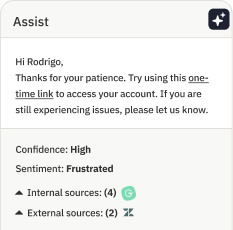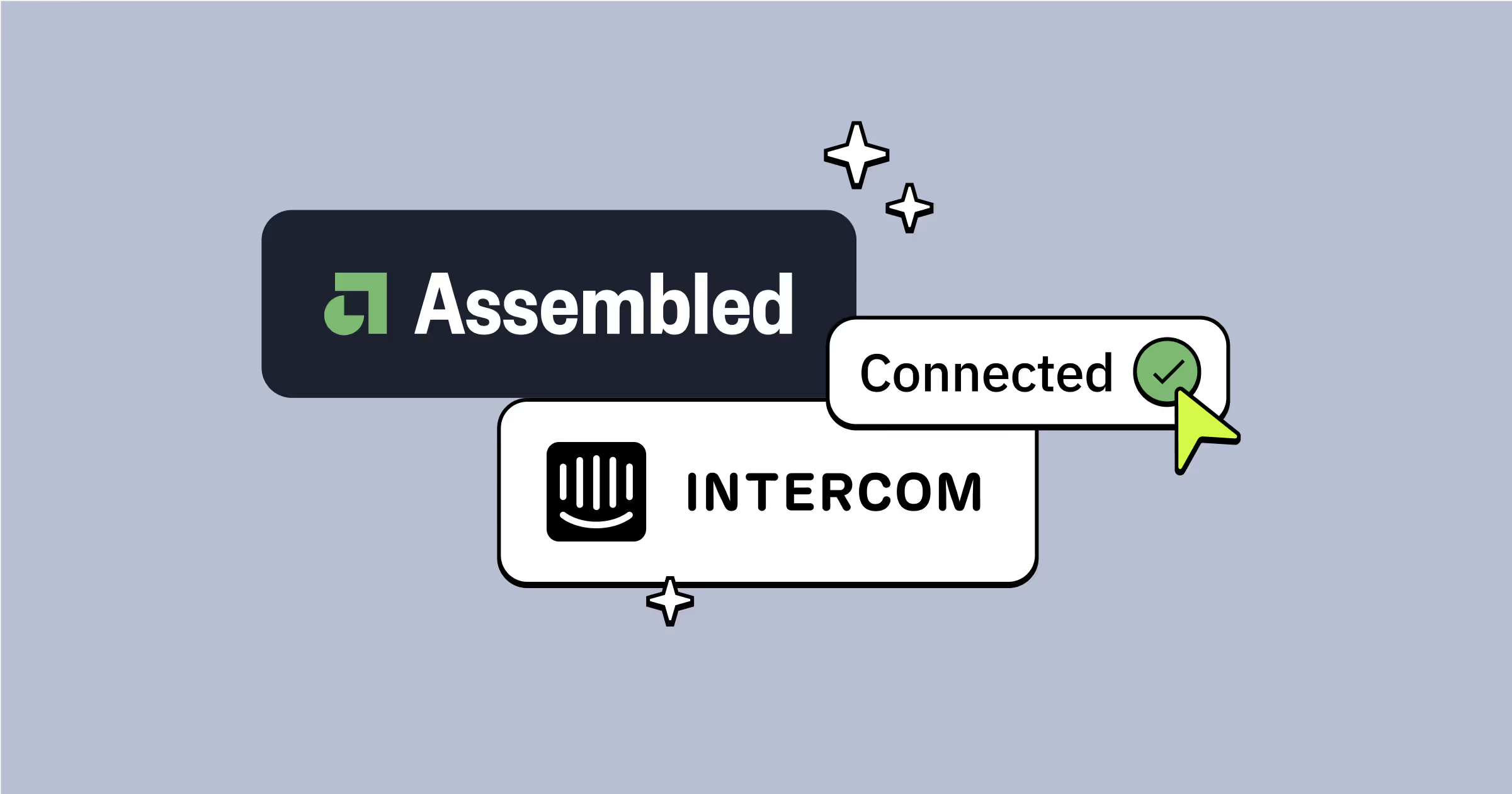Workforce forecasting: How to get smarter about scheduling

Accurate workforce forecasting helps organizations determine exactly how many team members they’ll need to meet projected customer demand — without wasting resources on unnecessary labor.
It involves analyzing historical trends, gauging upcoming events or product releases, and using these insights to predict future staffing requirements. The goal is to maintain a balance: too few employees hurts service quality; too many drives up labor costs.
What is workforce forecasting?
Workforce forecasting is the process of predicting how many employees — along with the skills they possess — will be needed to manage future workloads. Businesses look at trends in historical data, upcoming sales or marketing efforts, and external factors like seasonality to create staffing models that minimize both service bottlenecks and unnecessary labor costs.
- Historical trends: Analyzing previous performance provides a solid foundation for any workforce forecast. In industries with seasonal peaks or recurring surges, past call volumes, ticket inflows, or store traffic can highlight times when extra staff may be required.
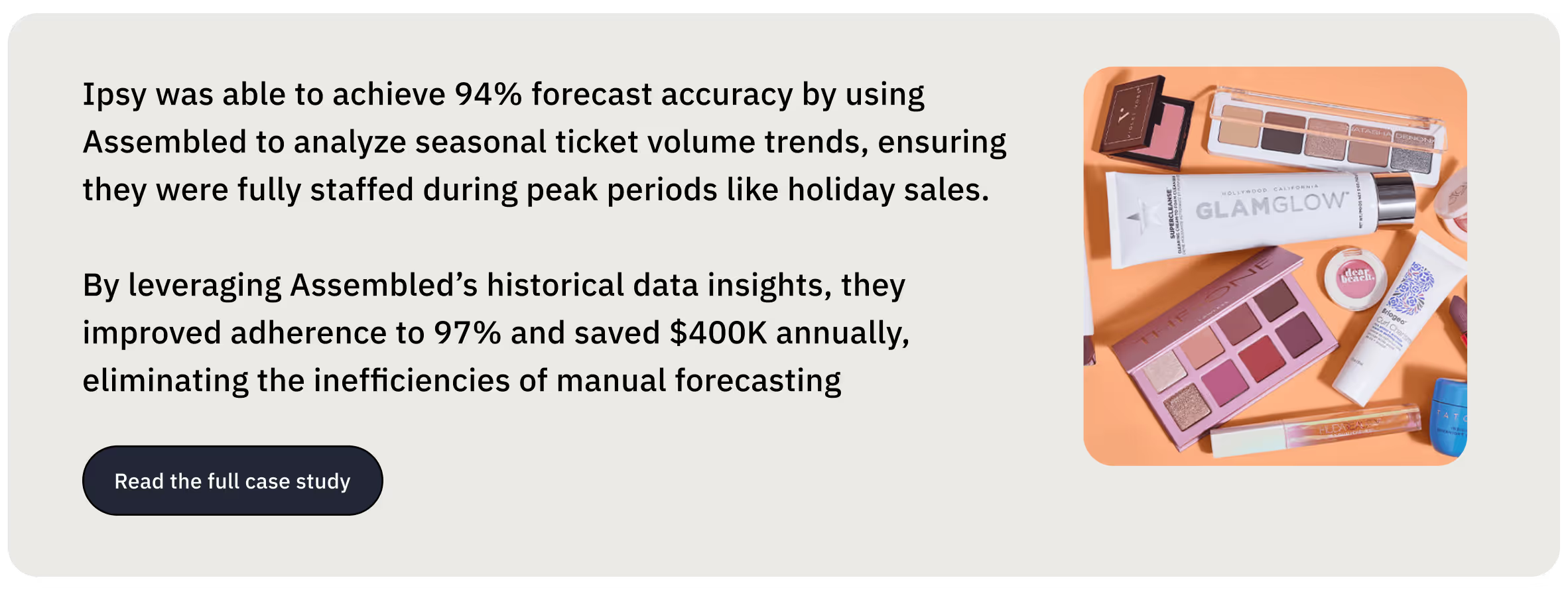
- Forward-looking indicators: While historic data offers insight into patterns, future events — such as new product launches, marketing campaigns, or unexpected supply chain disruptions — can shift staffing needs. Effective forecasting accounts for these potential changes so that teams can respond quickly.

- Balancing efficiency and quality: At its core, workforce forecasting is about ensuring operational efficiency and maintaining high service standards. If staffing dips below demand, customers face long wait times and subpar experiences. If overstaffed, payroll expenses increase without tangible benefits.
Assembled makes forecasting seamless by analyzing historical contact volume trends, layering in real-time queue insights, and projecting out email backlog, for a truly dynamic staffing engine. Instead of using static models that fail to capture business fluctuations, Assembled continuously refines forecasts based on live data, ensuring teams have the right staffing levels at all times.
Workforce managers can factor in monthly or annual seasonal patterns, marketing campaigns, or unexpected outages directly within the platform — without relying on spreadsheets or manual workarounds. Live insights across every channel empower managers to proactively adjust schedules before any issues arise, maintaining service levels without overspending on unnecessary headcount.

The benefits of workforce forecasting
Employers who use workforce forecasting enjoy more than just an optimized headcount. They also gain a competitive advantage by aligning labor with business objectives, cutting unnecessary costs, and improving customer experiences. Here are four primary benefits to consider:
1. Precise cost control
Overstaffing increases labor costs, while understaffing leads to overtime expenses, SLA breaches, and customer dissatisfaction. A well-structured forecast allows teams to align staffing with projected demand, preventing both unnecessary payroll costs and last-minute scheduling crises.
How forecasting helps:
- Optimized staffing allocation: Analyzing historical ticket trends, seasonal fluctuations, and backlog accumulation helps teams predict demand and schedule staff accordingly.
- Better budget planning: Comparing forecast models over time helps refine projections and reduce gaps between projected vs. actual workload.
2. Consistent service quality
Poor forecasting leads to longer wait times, ticket backlogs, and inconsistent service experiences, damaging customer trust. When teams accurately predict workload, they can maintain response times, meet SLAs, and improve overall customer satisfaction.
How forecasting helps:
- Preemptive staffing adjustments: Analyzing historical data alongside real-time metrics allows teams to anticipate volume spikes before they affect response times.
- Continuous performance tracking: Comparing forecast accuracy vs. actual demand ensures ongoing improvements in staffing plans.
3. Informed decision-making
Instead of waiting for a crisis to determine staffing needs, leaders can predict peaks and plan accordingly. This shift enhances long-term workforce planning while allowing for real-time adjustments in response to sudden surges or market fluctuations.
How forecasting helps:
- Incorporating external factors: Predictive forecasting models allow teams to factor in product launches, marketing campaigns, and regional events when planning staffing needs.
- Balancing long-term vs. short-term planning: Locking forecasts at different time horizons ensures a mix of long-term stability and short-term flexibility to adjust as needed.
4. Enhanced employee morale
When employees constantly scramble to cover gaps, frustration and burnout can set in. Conversely, overstaffing can lead to idle time and a lack of challenge. Balancing workloads with data-driven forecasts promotes a healthier work environment and ultimately improves retention.
How forecasting helps:
- More predictable workloads: Balancing staffing prevents workload surges that overwhelm agents while avoiding idle time that leads to disengagement.
- Proactive shift adjustments: Real-time tracking allows workforce managers to redistribute shifts when demand shifts unexpectedly, avoiding last-minute disruptions.
When it comes to channel forecasting, there’s a big difference in how teams plan for live versus asynchronous channels. Most workforce management tools treat email forecasting like chat or phone support — only accounting for incoming volume.
Assembled was purpose-built for teams that run support on all channels, email included. Our forecasts factor in email-specific features like backlog accumulation and longer-term SLA targets. This means teams can staff not just for today’s new cases, but also for unresolved tickets from previous days. This ensures that SLAs on live channels don’t suffer due to lingering email backlogs.
Typeform, for instance, was able to increase forecast accuracy to more than 90%, and eliminate the need for daily manual forecast adjustments.
Workforce forecasting best practices
Even the most advanced data models can fall short without the right processes and mindset. Below are several best practices that help maintain accuracy and agility in workforce forecasting.
1. Centralize your data
Consolidating key metrics — from historical scheduling records to customer engagement stats — ensures a single source of truth. This reduces data silos and makes it easier to spot trends across different teams or channels.
- Tip: Consider a unified platform that pulls data from CRM, ecommerce, and support tools, then presents a holistic view of demand.
Assembled’s integrations with Zendesk, Salesforce, Gladly, and Intercom pull historical contact volume and real-time agent state data into one unified dashboard. We’ll generate a staffing plan that can accommodate expected volume while remaining agile enough to adapt as conditions change.
Instead of relying on static reports or manual spreadsheet exports, Assembled continuously updates forecasts based on real-time ticket volume, email backlog, and agent availability, ensuring that staffing plans reflect actual demand as it shifts. This seamless data flow eliminates the need to switch between platforms or manually reconcile information, reducing errors and saving teams hours of manual effort each week.

2. Allow room for flexibility
Market conditions and consumer behavior can shift abruptly. Building in contingency plans like on-call staff or flexible shift structures prevents last-minute scrambles.
- Example: A support team can designate a subset of agents as “floaters” to handle unexpected ticket surges on short notice.
3. Involve key stakeholders
Accurate forecasting should include input from finance, operations, and frontline teams. Finance provides budget constraints, operations projects output, and the frontline offers practical insights into day-to-day needs.
- Advice: Schedule regular cross-departmental check-ins to update forecasts based on changing business priorities.
4. Use leading indicators
Historical data is foundational, but it only shows where you’ve been. Leading indicators such as upcoming product launches or planned marketing campaigns offer predictive insights that refine forecasts before demand changes become obvious.

5. Review and refine regularly
Even a well-built forecast requires periodic tuning. Evaluate accuracy against actual outcomes — if forecasts are consistently off, dig into why. Do you need more accurate data? Are you missing certain variables?
- Tip: Keep a record of forecast deviations and their causes. Over time, you’ll learn which factors have the greatest impact on your staffing levels.
Workforce forecasting methods and models
Effective workforce forecasting relies on different mathematical methods to predict future staffing needs based on historical data, trends, and external factors. These methods fall into four broad categories:
- Time-series forecasting: Uses historical data patterns to predict future demand. This includes trend smoothing, which minimizes short-term fluctuations to better reflect gradual increases or decreases in ticket volume.
- Seasonal adjustments: Accounts for recurring patterns in workload, such as holiday spikes, annual renewals, or predictable product cycles. This ensures forecasts reflect year-over-year demand fluctuations rather than treating every period as the same.
- Predictive forecasting: Incorporates machine learning and statistical models that analyze long-term trends, external variables, and real-time data to create adaptive forecasts.
- Comparative forecasting: Compares multiple forecast models side by side, helping teams plan for best-case, worst-case, and expected demand scenarios — especially useful for BPO/vendor management and contingency staffing plans.
Assembled applies these forecasting methods through four distinct models, allowing teams to select the approach that best fits their specific workload and operational requirements.
Whether your team has steady demand, seasonal peaks, or unpredictable surges, Assembled’s models help optimize staffing by analyzing historical trends, adjusting for real-time changes, and allowing teams to compare forecast accuracy over time.
Below, we outline each model, who it’s best for, and some additional considerations for evaluating whether the model is best suited for your needs.
1. N-week average forecasting (time-series + trend smoothing)
This model calculates the average ticket volume over a set number of weeks and uses that baseline to project future staffing needs. It works best for teams with relatively stable demand patterns and minimal short-term fluctuations.
- Best for: Teams with consistent inbound volume, where historical demand is a reliable indicator of future workload.
- Consideration: Works well as a starting point but may not capture sudden shifts in demand caused by product launches, seasonality, or marketing events.
Assembled gives teams full control over their forecasting cadence with configurable N-week averages, allowing them to fine-tune look-back periods — whether it's a 4-week view for short-term agility or an 8-week average for more stable demand patterns. By tailoring forecasts to match operational rhythms, teams can reduce variability and improve staffing accuracy.

2. N-week average with momentum
This model builds on the N-week average but adjusts for recent trends, ensuring that forecasts are not entirely backward-looking. It helps teams account for recent increases or declines in ticket volume when staffing for upcoming weeks.
- Best for: Support teams that experience gradual workload shifts rather than abrupt spikes, such as a company rolling out a phased product update.
- Consideration: This model is more adaptive than standard N-week averaging but still may not fully capture seasonality or rapid demand surges.
Assembled’s N-week average with momentum model automatically detects trends by applying a line of best fit to past data, giving more weight to recent shifts in volume. It adjusts forecasts based on interval-level patterns, ensuring staffing keeps pace with gradual increases or declines. For example, if a 9 a.m. Monday interval typically sees 20% higher volume than average, Assembled adjusts the forecast accordingly.

3. Seasonal model
This model is designed for teams that experience clear seasonal fluctuations in workload. It analyzes year-over-year trends to anticipate spikes and lulls, making it ideal for businesses with holiday rushes, annual sales events, or cyclical support patterns.
- Best for: Retail and ecommerce teams, tax software companies, and any industry with recurring high-traffic periods.
- Consideration: Works best when multiple years of historical data are available to detect repeatable trends.
Assembled’s seasonal forecasting model predicts volume fluctuations by analyzing over a year of historical data, making it ideal for teams with recurring surges like holiday sales, monthly subscriptions, or tax season. It detects weekly, daily, and interval-level trends, automatically adjusting forecasts based on long-term growth. This ensures teams prepare for spikes in advance, avoiding last-minute staffing changes.
The model is also highly customizable, allowing teams to fine-tune forecasts for unique operational patterns, including non-traditional cycles that don’t follow a standard 7-day cadence.
4. Prophet model
The Prophet Model (based on Facebook’s Prophet algorithm) is the most advanced forecasting option in Assembled. It combines seasonality, historical trends, and external factors to create adaptive, long-term workforce forecasts.
- Best for: Teams that need highly flexible, long-range forecasting that adapts to complex, multi-variable trends.
- Consideration: Works well for high-growth companies and organizations with evolving customer support needs, but requires ongoing monitoring to fine-tune accuracy.
Assembled’s Prophet model uses machine learning to forecast long-term trends, automatically detecting seasonality, growth patterns, and external events like holidays or product launches. Built on Meta’s Prophet library, it dynamically adjusts forecasts to keep staffing aligned with demand. Ideal for teams managing multiple seasonal cycles or growth shifts, this model prioritizes accuracy over explainability, making it a powerful choice for organizations needing data-driven, adaptable forecasting.
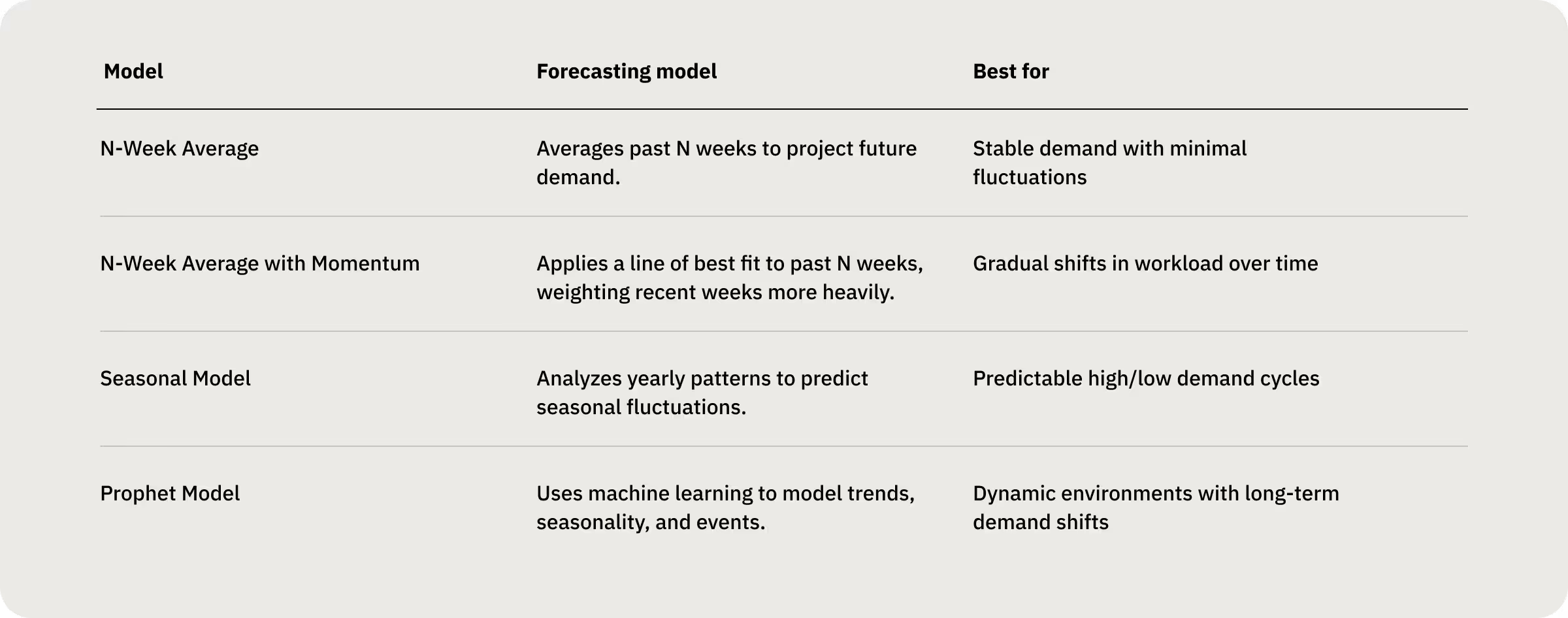
Implementing workforce forecasting in your organization
Moving from theory to practice involves more than installing new software. It requires buy-in across departments, a clear plan for data management, and ongoing commitment to iterative improvement. Below is a recommended roadmap:
1. Define objectives and scope
- Identify key forecasting goals such as improving SLA adherence, optimizing headcount, or reducing backlog accumulation.
- Determine whether you need short-term forecasts (weekly/monthly adjustments) or long-term workforce planning (quarterly/yearly staffing projections).
2. Gather and clean your data
- Centralize all relevant data sources, including historical ticket volume, staffing schedules, and backlog trends.
- Ensure consistent data inputs across email, chat, phone, and vendor-managed queues to prevent forecasting errors.
3. Select and configure tools
- Choose the best forecasting model based on workload patterns (e.g., N-week average for steady demand, seasonal model for cyclical spikes).
- Configure forecast lock settings (e.g., how far in advance forecasts should remain adjustable vs. locked for scheduling) to align with your staffing lead times.
4. Pilot and refine
- Start with a single queue, department, or region before applying forecasting across the entire organization.
- Measure forecast accuracy using key error metrics (e.g., mean absolute error, over/under error) and adjust inputs accordingly.
5. Scale and monitor
- Once a model has been validated, expand it to additional teams, regions, or BPO vendors.
- Implement regular forecast audits to track ongoing performance.
A structured rollout ensures that workforce forecasting becomes a living process rather than a one-time initiative. Over time, feedback loops and continuous improvements will keep forecasts sharp, reducing both staffing inefficiencies and unexpected labor costs.
Gather and clean your data
Accurate forecasting starts with centralized, real-time data. Assembled integrates with help desk tools like Salesforce, Zendesk, and more, eliminating manual errors by pulling accurate live data. By centralizing data, for example, a team managing both in-house and outsourced support can track volume trends across all vendors at once for better staffing. With native data validation, Assembled ensures that all your ticket mapping is accurate before going live.
Select and configure tools
The Assembled Forecast Management tool allows you to see the accuracy of all forecast models in one easy comparison table. This means you’ll be able to see the results of our accuracy reporting before you commit to a model. You can also swap between models at any time.
Pilot and refine
The Forecasted vs. Actual Report in Assembled provides visibility into forecast accuracy by comparing projected vs. actual demand. This helps teams identify discrepancies, adjust models, and improve precision over time.
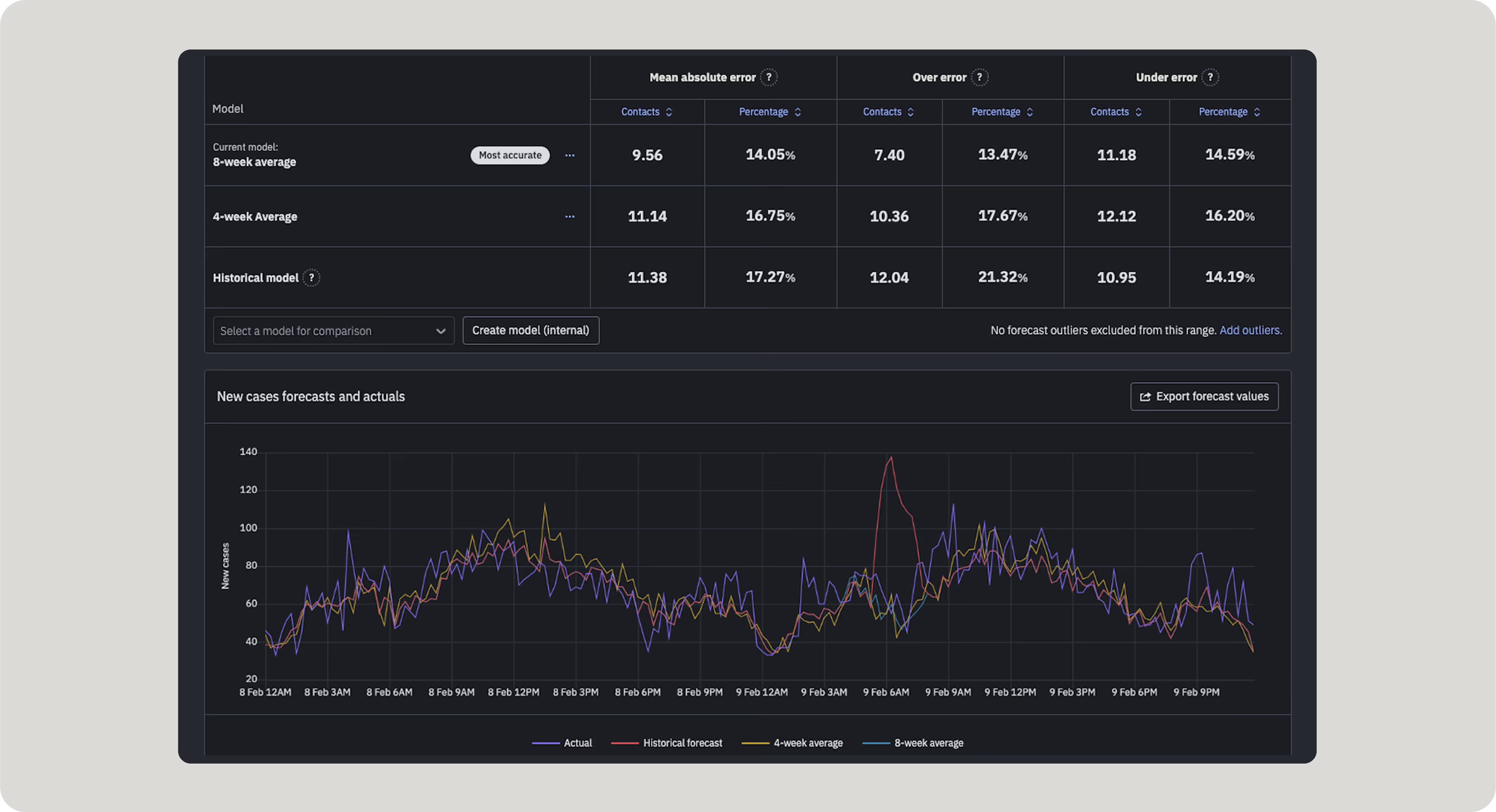
Bringing workforce forecasting into practice
Effective workforce forecasting helps teams staff efficiently, control costs, and maintain service quality. Without the right tools, teams risk reactive scheduling, budget overruns, and service disruptions.
Assembled provides precise, adaptable forecasting models that integrate with ticketing platforms to ensure staffing keeps pace with real-world demand. Whether managing in-house agents, vendors, or BPO partners, workforce managers can reduce uncertainty, improve forecast accuracy, and refine staffing strategies over time.
See Assembled in action today with a self-guided demo and discover how better forecasting leads to smarter staffing decisions.

